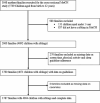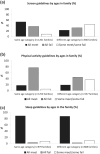Adherence to 24-h movement behaviour guidelines in families with multiple children
- PMID: 38105630
- PMCID: PMC10952476
- DOI: 10.1111/cch.13213
Adherence to 24-h movement behaviour guidelines in families with multiple children
Abstract
Background: In 2019, the World Health Organization (WHO) launched the first global movement guidelines for children that combined sleep, physical activity and screen time. Our previous research showed that adherence to age-specific guidelines for screen time was challenging for families with children in different age groups. We aimed to determine whether families with children in different age-based movement guideline categories have poorer adherence to the broader 24-h movement guidelines than those with all children in the same age category.
Methods: Data were from the 1973-1978 cohort of the Australian Longitudinal Study on Women's Health (seventh survey, 2015) and the women's three youngest children (aged ≤12) (Mothers and their Children's Health sub-study, 2016/2017). The sample was 1787 women (families) with 4064 children (mean age 7.2 [SD 2.9]). Whether children in the family were in the same or different age-based category was determined by matching children's ages in a family against age-based guideline categories for the 24-h movement behaviours. The association between children in the family being in the same or different age-based guideline category on adherence to 24-h movement guidelines, both collectively and individually, was analysed by adjusted logistic regression (binary and multinomial).
Results: Families with children in the same age guideline categories had double the odds of having all children meet 24-h movement guidelines (adjusted odds ratio [OR] 1.95 [95% confidence interval, CI: 1.32, 2.86]). Families with children in the same age categories on the screen guideline had higher odds of all children meeting (2.25 [1.73, 2.93]) and lower odds of some meeting/some failing the screen guideline (0.18 [0.14, 0.25]), than families with all children in different age categories. Families with children in the same age categories on the physical activity guideline had lower odds of all children meeting (0.57 [0.43, 0.75]) or some meeting/some failing the physical activity guideline (0.08 [0.06, 0.12]). No associations were found for sleep guidelines.
Conclusions: Families with multiple children may need practical advice and strategies on how to adhere to guidelines when children span age categories. This could form part of public health strategies that raise awareness of the guidelines and may improve guideline adherence.
Keywords: 24-h movement behaviour; children; physical activity; screen time; siblings; sleep.
© 2023 The Authors. Child: Care, Health and Development published by John Wiley & Sons Ltd.
Conflict of interest statement
The authors declare that they have no conflicts of interest.
Figures



Similar articles
-
Twenty Four-Hour Movement Behaviours Research Among Australian Children and Adolescents: A Scoping Review.Health Promot J Austr. 2025 Apr;36(2):e70021. doi: 10.1002/hpja.70021. Health Promot J Austr. 2025. PMID: 39967550 Free PMC article.
-
Adherence to 24-Hour Movement Guidelines for the Early Years and associations with social-cognitive development among Australian preschool children.BMC Public Health. 2017 Nov 20;17(Suppl 5):857. doi: 10.1186/s12889-017-4858-7. BMC Public Health. 2017. PMID: 29219104 Free PMC article.
-
Parental impact on adherence of young children to 24-h movement behaviour guidelines: the Czech FAMIly Physical Activity, Sedentary behaviour and Sleep study.Eur J Public Health. 2025 Apr 1;35(2):295-301. doi: 10.1093/eurpub/ckae224. Eur J Public Health. 2025. PMID: 39798164 Free PMC article.
-
Association between 24-hour movement behaviors and health-related quality of life in children.Qual Life Res. 2022 Jan;31(1):231-240. doi: 10.1007/s11136-021-02901-6. Epub 2021 Jun 3. Qual Life Res. 2022. PMID: 34085133 Free PMC article.
-
The whole day matters: Understanding 24-hour movement guideline adherence and relationships with health indicators across the lifespan.J Sport Health Sci. 2020 Dec;9(6):493-510. doi: 10.1016/j.jshs.2020.07.004. Epub 2020 Jul 22. J Sport Health Sci. 2020. PMID: 32711156 Free PMC article.
Cited by
-
Twenty Four-Hour Movement Behaviours Research Among Australian Children and Adolescents: A Scoping Review.Health Promot J Austr. 2025 Apr;36(2):e70021. doi: 10.1002/hpja.70021. Health Promot J Austr. 2025. PMID: 39967550 Free PMC article.
-
Global research on 24-hour movement behaviours guidelines in children and adolescents: a systematic review.Int J Behav Nutr Phys Act. 2025 Aug 8;22(1):108. doi: 10.1186/s12966-025-01809-5. Int J Behav Nutr Phys Act. 2025. PMID: 40781309 Free PMC article. Review.
References
-
- Australian Department of Health . (2021). Australia's physical activity and sedentary behaviour guidelines and the Australian 24‐hour movement guidelines. Australian Department of Health. Available at: https://www.health.gov.au/health-topics/physical-activity-and-exercise/p.... [accessed 14.02.2022]
-
- Australian Institute of Health and Welfare . (2018). Physical activity across the life stages. Australian Institute of Health and Welfare. Available at: https://www.aihw.gov.au/reports/physical-activity/physical-activity-acro.... [accessed 14.02.2022]
-
- Australian Institute of Health and Welfare . (2020). Australia's children. Australian Institute of Health and Welfare. Available at: https://www.aihw.gov.au/reports/children-youth/australias-children/conte.... [accessed 14.02.2022]

